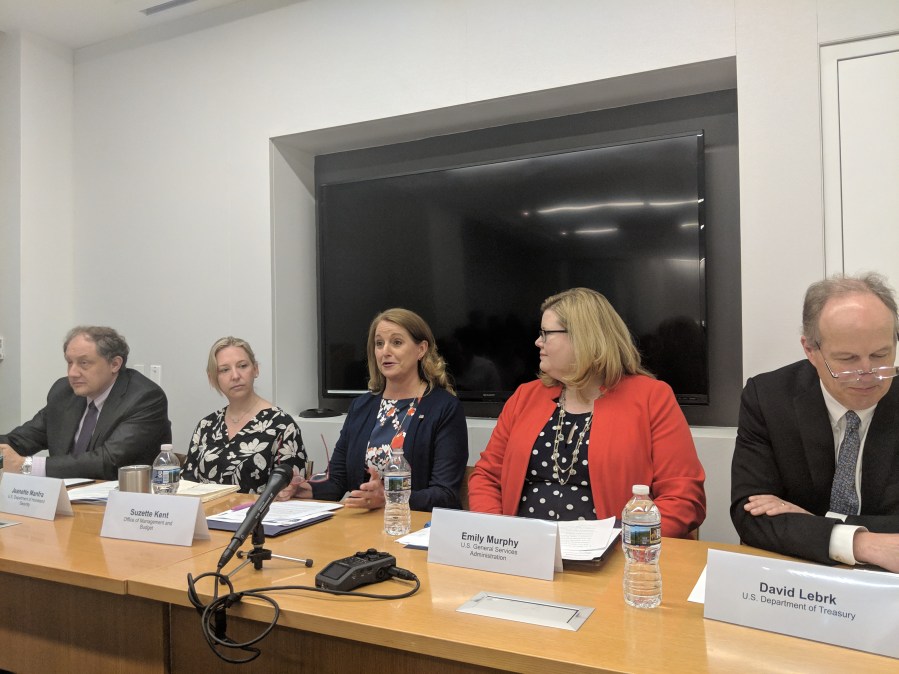OMB issues a new model for federal shared services

The Office of Management and Budget issued a shared services policy Friday designating four initial agencies as leads on governmentwide standardization efforts around technology and other common solutions.
Through the Quality Services Management Offices, or QSMOs, the General Services Administration will oversee a human resources marketplace, the Department of Treasury one for financial services, the Department of Health and Human Services one for grants management, and the Cybersecurity and Infrastructure Security Agency one for cybersecurity.
All four QSMOs will be used as common resources by agencies across the government as an alternative to standing up their own efforts.
Mission-support services like finance management, travel and payroll cost agencies more than $25 billion annually. By eliminating redundant contracts, human resources and technology between agencies, the government could save anywhere from 5 to 30 percent, according to OMB.
“This is not a project,” Suzette Kent, federal CIO, told reporters. “It’s a fundamental change in our operating model for how we deliver common services across the entire federal government.”
But first agencies must agree on standards for future shared services, Kent added, which is why the “Centralized Mission Support Capabilities for the Federal Government” memo’s release launches a planning phase.
Within 30 days, the 24 Chief Financial Officers Act agencies must appoint a senior accountable point of contact to coordinate actions and support the strategy’s adoption.
GSA will manage programs, the Shared Services Governance Board (SSGB) will serve as a steering committee recommending standardization opportunities to OMB, and the Business Standards Council will design integrations. Data standards will continue to be set by designated policy offices, according to the memo.
The SSGB and QSMOs will refresh the strategy over time, while OMB and GSA — as co-leaders of the cross-agency priority goal for shared services within the President’s Management Agenda — will conduct assessments to designate new QSMOs when a new capability is deemed ready for centralization. According to OMB’s website for the new strategy, the “initiation and research phase” is underway for QSMOs on assisted acquisition, contract writing systems, customer experience, FOIA, travel and real property management.
QSMOs must manage a marketplace of competitive solutions for technology and services for customer agencies or else help them build a business case when one does not exist. New QSMOs create five-year implementation plans that OMB will approve.
When a QSMO is designated, legacy systems will be phased out, and providers must work with them to modernize tech and reskill employees. QSMOs will generally handle solicitations around such efforts, according to the memo.
“In tandem, improving the overall administrative support for the federal workforce is also a key goal of this effort,” reads the memo.
Agencies are expected to do human capital planning 24 to 36 months out where roles are expected to be impacted by the designation of QSMOs.
The shared services strategy’s impact on the workforce “is going to be a dialogue,” Kent said, and in the near term will be felt around payroll, security services and financial management.
Workers may need new skill sets to handle new systems or be transitioned out of “clunky” data-entry roles, said Emily Murphy, administrator for GSA
“The global approach on shared quality services has not been that this is about reducing the size of the federal workforce,” Murphy said. “This is about making sure we’re … doing higher value work.”
The new policy rescinds prior guidance, including a 2016 directive the Obama administration issued that institutionalized initiatives and strategies developed by the Unified Shared Services Management office at GSA.
Standing up the QSMOs
GSA’s first step as QSMO for civilian human resource transaction services is the launch of the NewPay Initiative to address aging and outdated payroll systems.
“Because of some of those aged systems, we have business processes as well that are more brittle,” Kent said. “We’re not taking advantage of the great things that GSA has acquired now that are new and on the market and can actually lead to a better experience for every federal worker.”
The agency received $20.7 million from the Technology Modernization Fund to accelerate the implementation of NewPay across the federal government. NewPay makes it easier for agencies to pay employees with fewer errors, Murphy said.
GSA also offers a fleet program to agencies supporting 200,000 of the government’s 600,000 vehicles, saving them an average of 23 cents per mile or $350 million across government annually.
The Department of Treasury will work to reduce the footprint of the approximately 40 core financial management systems used among agencies and automate processes. Many such systems are customized in such a way that they can’t produce standardized reports easily.
“If it’s going to be done the right way, it’s going to need to be a multi-year effort with respect to making sure agencies are in the right place to make the changes they need to make,” said David Lebrk, fiscal assistant secretary with the department.
As a grants QSMO, HHS will help customer agencies access technologies to mitigate waste, fraud and abuse in the grantmaking process across the government, which awards about $700 billion annually. The department is one of the largest grantmakers in the U.S., particularly when it comes to health and scientific research, awarding more dollars than all other agencies combined.
For cybersecurity, the Continuous Diagnostics and Mitigation (CMD) program has saved the government $600 million through its first two phases, said Jeanette Manfra, assistant director of CISA within the Department of Homeland Security. CISA will focus its QSMO on reducing customer agencies’ cyber risk by continuing the work of CDM and providing services like endpoint and privileged access management, she said.
“As a part of the standup of our new agency it’s also giving us the opportunity to take a more strategic look and continue on the president’s cybersecurity executive order from May of 2017 to understand where agencies are in their risk profile and align services against those agencies that are at greatest risk,” Manfra said.
Customer agencies already want CISA services like security operations centers and vulnerability disclosure policies and implementation. But they don’t always have the necessary resources, Manfra said, so it’s more cost efficient for CISA to offer consolidated services.
Still, other services like intrusion prevention are required of agencies by law.
“My ideal is not mandating a bunch of services on them; that gets very complicated,” Manfra said. “But instead providing valuable services that they want to take part in and will help them achieve OMB’s policies.”
Agencies will be pulled toward the shared services QSMOs offer because of their higher quality and defined standards, Kent said.
But there’s also a push element.
“In the operational structure — if someone wants to go out and acquire something different or do something different — their first stop is with the quality service management lead to understand how that aligns with the standards that have been set and the suite of solutions that’s already available,” Kent said.






